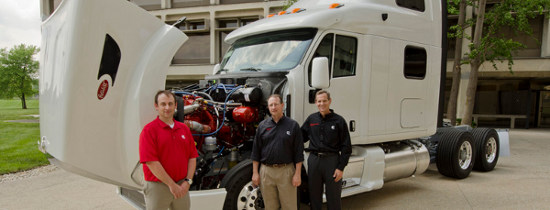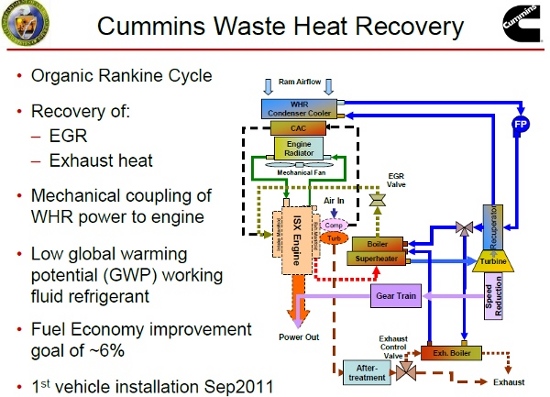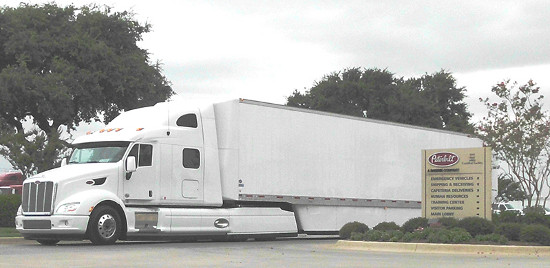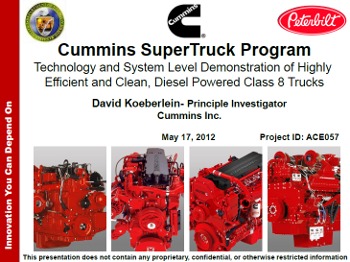 |
| March 26, 2013 | Volume 09 Issue 12 |
Designfax weekly eMagazine
Archives
Partners
Manufacturing Center
Product Spotlight
Modern Applications News
Metalworking Ideas For
Today's Job Shops
Tooling and Production
Strategies for large
metalworking plants
Wheels:
SuperTruck delivers 54 percent increase in fuel economy
Today's long-haul trucks typically achieve between 5.5 and 6.5 mpg. That's about to change for the better ... the much, much better.
Cummins Inc. and Peterbilt Motors Company recently released test results showing their demonstration tractor-trailer achieved a 54 percent increase in fuel economy, averaging nearly 10 mpg under real-world driving conditions.

Some members of Cummins' SuperTruck team stand next to the tractor before its trip to Texas for the start of critical testing in the fall of 2012. From left to right, Jon Dickson, vehicle applications leader - Advanced Engineering; David Koberlein, SuperTruck principal investigator; and Wayne Eckerle, vice president - Research and Technology. [All images courtesy: Cummins Inc.]
The "SuperTruck" developed by the two companies features a higher-efficiency engine and an aerodynamic tractor-trailer that significantly reduces drag. The truck also includes a system that converts exhaust heat into power delivered to the crankshaft, electronic controls that use route information to optimize fuel use, tires with lower rolling resistance, and lighter-weight material throughout.
The Class 8 Peterbilt 587 powered by a Cummins ISX15 engine averaged 9.9 mpg during testing last fall on U.S. Route 287 between Fort Worth and Vernon, Texas. The testing was conducted over 11 runs meeting SAE International test standards along a 312-mile route. The tractor-trailer had a combined gross weight of 65,000 lb.
The 54 percent increase in fuel economy would save about $25,000 annually based on today's diesel fuel prices for a long-haul truck traveling 120,000 miles per year. It would also translate into a 35 percent reduction in annual greenhouse gases per truck.
The potential savings in fuel and greenhouse gases are enormous, with about 2 million registered tractor-trailers on U.S. roads today, according to The American Trucking Association.
About the waste-heat recovery system
Cummins engineers have worked hard developing a waste-heat recovery system for SuperTruck. The system is similar to how steam power plants operate. Here's a quick look:
1. First, the system extracts waste heat from the exhaust system via a pressurized refrigerant.
2. Next, the pressurized, heated refrigerant expands across a small turbine on the engine, creating power.
3. Finally, the power generated by the turbine goes back to the engine shaft, helping to push the vehicle forward and reducing the need for diesel fuel.

In addition to the fuel-economy improvements, the truck also demonstrated a 61 percent improvement in freight efficiency during testing compared to a baseline truck driving the same route. That significantly exceeded the 50 percent SuperTruck program goal set by the U.S. Department of Energy. Freight efficiency is an important metric in the transportation industry that is based on payload weight and fuel efficiency expressed in ton-miles per gallon.
"Many of the technologies we are testing on the engine and truck will be integral parts of the trucks of tomorrow," says David Koeberlein, principal investigator for the SuperTruck program at Cummins. "We are focused on developing innovations that meet and exceed the needs of our customers, while helping to create a cleaner, healthier, and safer environment."
Cummins personnel have been focused on the engine and its integration with the powertrain. They have been working with several other companies and research institutions to develop numerous changes in the combustion system as well as advances to reduce internal friction and so-called "parasitic power" -- excess power the engine needs to run such things as lube and coolant pumps and air compressors.
In addition to the truck's exterior, Peterbilt and its partners have been working on improvements in the drivetrain, the idle management system, weight reduction, and vehicle climate control. Eaton's advanced transmission facilitates further engine downspeeding for additional fuel-economy benefits.
"Aerodynamics has been a significant contributor to the efficiency gains," says Scott Newhouse, senior assistant chief engineer of Product Development at Peterbilt. "We are very pleased with what our team has been able to accomplish using a comprehensive tractor-trailer approach."

Cummins is a prime contractor leading one of four vertical teams under the Department of Energy's SuperTruck project. SuperTruck is one of several initiatives under the 21st Century Truck Partnership, which is a public-private partnership founded to further stimulate innovation in the trucking industry through the sponsoring government agencies, companies, national laboratories, and universities.
Cummins, Peterbilt, and their program partners will have invested $38.8 million in private funds over the four-year life of their SuperTruck program, which started in 2010, with critical support coming through awarded matching grants from the Department of Energy's Vehicle Technologies Program.
Testing will continue in 2013 on a new Peterbilt 579 that Cummins and Peterbilt are confident will take what has been achieved so far to even higher levels. The testing will address use of the tractor-trailer over a 24-hr period, including periods when drivers are at rest but still need power for such things as air conditioning and small appliances.
The engine work is only part of the SuperTruck project that Cummins is leading. Peterbilt Motors Company, a division of PACCAR, is designing a tractor-trailer exterior with less drag.

Want to know more details about the Cummins/Peterbilt SuperTruck project? You can view an in-depth 2012 presentation (PDF) by clicking here.
Eaton and Dana are developing drivetrain improvements. Delphi is working on a fuel cell to reduce or eliminate the idling of trucks when drivers are asleep or resting. And those are just some of the companies involved in the effort.
Daimler/Freightliner, Navistar and Volvo are also leading SuperTruck projects, developing their own visions of trucking's future.
The total cost of the SuperTruck initiative is about $270 million, including DOE grants and matching expenditures from the project participants.
Source: Cummins
Published March 2013
Rate this article
View our terms of use and privacy policy
